
|
W |
“Why don’t |
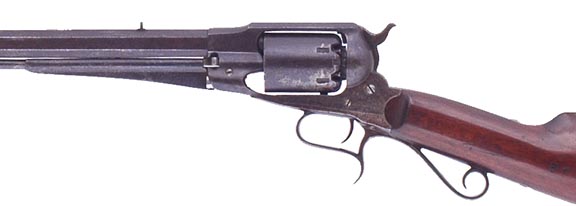
Remington Percussion Revolving Rifle serial number 141
|
It was |
A second reference found about the Remington Revolv- |
| Page 26 | 2nd Quarter 2007 |

The following, in chronological order, are other advertisements that list the Remington Revolving Rifle:
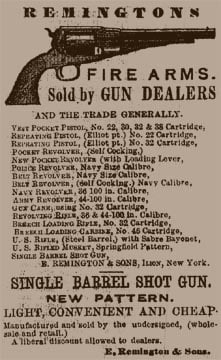
|
|
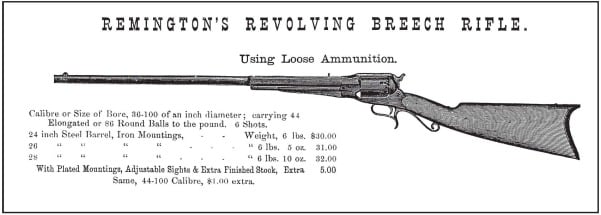
| Page 27 | 2nd Quarter 2007 |
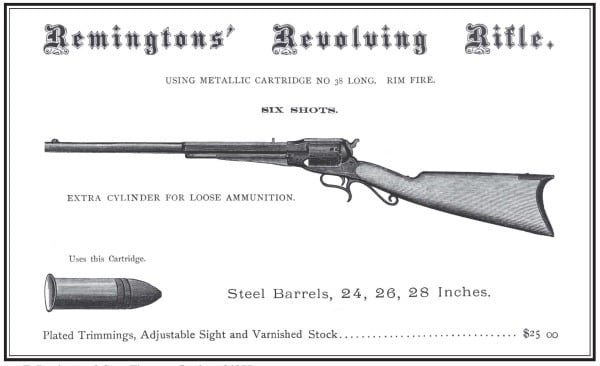
|
got me started looking into the ad’s, and the one that I
With the above information in mind, the last advertisement by Remington for the Revolving Rifle being in 1879, I find it easy to assume that final sales would have been in 1879 or shortly thereafter. |
| Page 28 | 2nd Quarter 2007 |
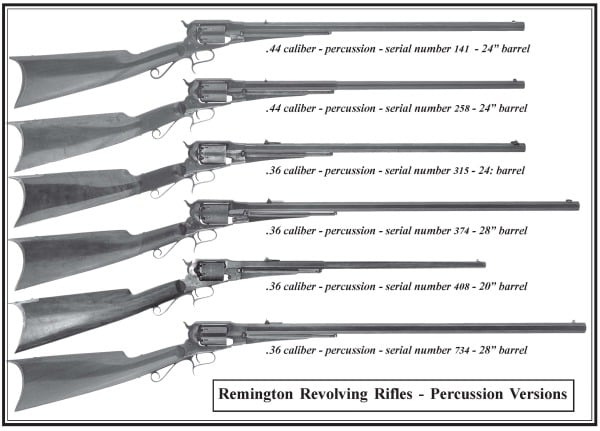
One of my research goals for the future is to gather information from various firearms distributor and dealer records that show
purchase and sale of the Remington Revolving Rifle, hoping that this might aid in clarifying production dates. Input by readers
toward this goal is encouraged.
While being briefly mentioned in various collectors’ price guides, in one or two magazine articles, and consuming a scant
quarter page in Edsall James book ‘The Revolver Rifle” published in 1974, my survey over the last several years has produced a
great deal of information concerning the Remington Revolving Rifle. And while this information answers several of the questions
I had, it also proved false, some previously published information, as well as raising many new questions. Most of these questions
relate to physical characteristics so I’ll address them a bit later in this article.
No doubt it’s obvious to most that the patents associated with the Revolving Rifle are the same as those associated with the
following firearms. The Remington-Beals Army/Navy Revolver, The Remington Old Model Army/Navy Revolver, and the Reming-
ton New Model Army/Navy Revolver. These patent numbers and dates are:
‘ U.S. Patent #21,478 for the Beals Revolver; dated September 14, 1858
‘ U.S. Patent #33,932 for the Old Model Revolver; dated December 17, 1861
‘ U.S. Patent #37,921 for the New Model Revolver; dated March 17, 1863
PHYSICAL PROPERTIES
The following information, while not etched in concrete, is based on information gleaned from approximately 60 survey forms
submitted by owners of Remington Revolving Rifles in the U. S., Canada and Europe. Included in this study, are the guns in my own
collection, which have been disassembled and examined closely, allowing me to state that the information received from other
collectors does not vary greatly from the information concerning my guns.
The Remington Revolving Rifle was initially produced in percussion models in two basic sizes, related to caliber. Both of these
sizes were later offered in rimfire cartridge models as well. These initial sizes were the .36 cal percussion cap & ball, and the .44 cal
percussion cap & ball. The cartridge conversions later offered were the .38 long rimfire and the .46 rimfire.
| Page 29 | 2nd Quarter 2007 |
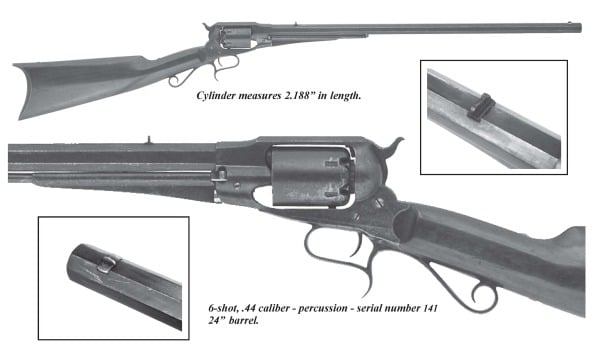
The capping plate conversion model utilizes the same design as on both the .38 and the .46 models.
Approximately one-third (17 of 56) of the rifles surveyed were of the larger caliber. Either .44 percussion or .46 rimfire, with
three of these 17 examples identified as being ‘non-factory” modified to accept .44 or .45 or .46 rimfire cartridges. Of the remain-
ing 14 large bore models, 9 rifles in the study group are identified as being .44 percussion, and five are verified to be .46 cal.
capping plate conversions. This .46 rimfire model was by far the scarcest, but as time goes on, more of these come to light.
Of the small bore models, numbers indicate that the ratio between percussion and cartridge model is approximately 50-50,
with 20 being .38 rimfire cartridge models and 19 being .36 cal percussion models.
All of the advertisements I’ve seen show the Remington Revolving Rifle as having a part hexagon, part round barrel. This
barrel type is, by far, the most scarce of the two barrel styles. The full octogon barrel represents approximately 90% of the rifles
reported.
Barrel lengths were well represented in the advertised 24″, 26″, and 28″ lengths, showing no pattern by serial number
sequence, caliber, or type of mountings. There were, however, two guns each that had barrel lengths listed at 30″ and 22″. I
personally inspected one of each of those and am satisfied that they both are factory guns. Both of the 22″ barrels were part
round part octagon, while both 30″ barrels were full octagon.
Barrel diameter, or the dimension across the flats, shows a vast majority in both calibers to be 3/4″ with a few measuring 11/16″ and a few measuring 13/16″. Most of the 13/16″ barrels, and at least one of the 3/4″ barrels, had a channel undercut on the bottom flat to allow proper seating of the loading lever without having to modify the link of the same.
While it is common to think that the cylinder length of 2-3/16″ is a quick way to determine if a particular firearm is factory
original, and it is a fact that 95% of those guns surveyed did in fact have this length cylinder, there are a couple of guns out
there with 1-15/16″ cylinders that I’d like to have a closer look at, because everything else in their survey forms indicates that
they are factory-produced guns. If we are to believe that the Remington factory did supply this rifle with the 1.9375″ cylinder,
then the frame design will also vary based on the length of the cylinder. Maybe Remington put out a few with 1.9375″ cylinders
during material shortages? If so, how did they decide which frame they would use. Would they have modified an existing
handgun frame to accept the stock, or would they have produced frames to fit a 1.9375″ cylinder?
All of the factory guns I’ve looked at that are .36 percussion, .44 percussion or .38 rimfire have 6-shot cylinders. One that I
own and others that I have surveyed appear to be a gunsmiths’ modification utilizing a bored thru cylinder and are 6-shot.
| Page 30 | 2nd Quarter 2007 |


The rear of that cylinder doesn’t leave much skin between the holes, leading me to believe that for safety reasons, Remington
limited the large bore models to 5 shots. All of the .46 rimfire capping plate style cylinders surveyed to date are 5-shot.
While all of the loading levers on factory rifles are 7 inches long overall, I have seen a few examples where the web is less
than the normal 5 inches long, and the rod may be pieced together from two lengths. This may be as the result of a repair during
the life of the gun, but I doubt that it left the factory that way. I have also seen loading levers on apparent gunsmith rifles that
are of the same length and design as used on Remington handguns.
I have seen a number of obvious gunsmith modifications to handguns (adding barrels of various lengths; a shoulder stock;
etc.) that use the normal handgun loading lever, frame, and cylinder.


| Page 31 | 2nd Quarter 2007 |

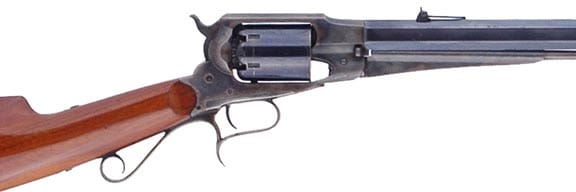
While all of the factory stocks that I’ve measured come in at 14″ with the same shape and
length of pull, close inspection of the stock on these gunsmith modification firearms show slight deviations from the factory
shape. Examine closely the example where the stock meets the frame. You’ll notice the length of the concave area, forming the
transition from the frame to the body of the stock. Now look at the example which is the Remington factory stock and you’ll see
a transition area of much smaller size.
The Remington Revolving Rifle was configured in variations, with a choice of front and rear sights, choice of wood grade
and finish, choice of iron or plated mountings, choice of caliber, choice of barrel length, and it was offered in an engraved model
as well, although not mentioned in any catalog or price list.
While the front sight offering appears to have been limited to a short blade, a long blade and a bead, rifles with the Beach
Combination Globe front sight do exist. Most of these examples appear to be those ordered with all of the options that were
offered at that time.
Rear sight variations have been noted as a fixed buckhorn sporting sight graduated for 50-300 yards, and two different
lengths of adjustable folding leaf sights.
The stock could be ordered in plain, or fancy, smooth or checked, oiled or varnished configurations. The fancy grade, with
checking and varnish is a very nice looking work of wood.
While plated mountings did cost extra at various points in its offering, most of the rifles surveyed did have them. Iron
trigger guards and butt plates are the exception rather than the rule.
.
Engraved rifles are very rare, with only two being surveyed. As was normal for Remington in that time period as well as is
the practice today, the engraving work is top quality. In addition to the engraving shown on rifle serial number 315, other areas
on the rifle that were engraved include the muzzle end of the barrel surrounding the front sight, as well as total coverage of both
pieces of the two-piece butt plate.
While at first glance, the trigger guard appears to be the same in shape on all models, a closer inspection reveals that there
are a possible four different models of trigger guard. These vary in the manner and number of attaching screws required to be
used. This variation has an effect on the frame as well, in that it is modified to match the trigger guard attaching screws. My
opinion is that each of the design changes, which resulted in an additional screw being used to attach the trigger guard,
increased the strength of the trigger guard.
The one screw trigger guard consists of a mounting plate with a tang on the rear that slides into a recessed area of the
frame, and a single machine screw holds the mounting plate and the frame together. The scroll portion of the trigger guard has a
threaded stud on the upper front area of the trigger guard which screws into the mounting plate. At the rear of the scroll assem-
bly, there is a single hole through which a wood screw is used to secure the assembly to the stock.
| Page 32 | 2nd Quarter 2007 |
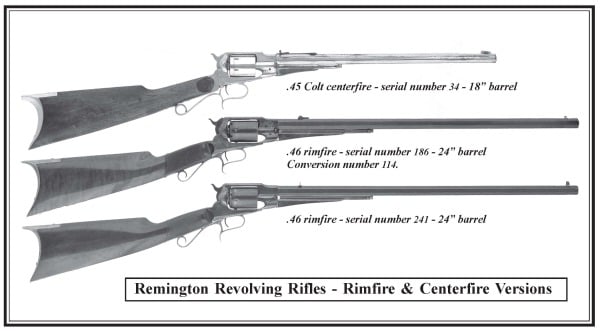
The two screw trigger guard, as reported by three different revolving rifle owners, has a screw at the front that attaches to
the frame, and a screw at the rear that attaches to the stock. As yet, I do not have a photo of this model, but when I do get one,
I’ll pay close attention to see if it’s really a three screw model.
The three screw trigger guard is similar to the two screw model in that it uses a screw at the front and the rear of the guard,
but a third screw has been added that is installed thru the left side of the frame, thru the guard and threaded into the right side of
the frame. This screw is located just to the rear of the finger opening in the trigger guard. If I’m correct in my assumption
concerning the two screw trigger guard, as well as my suspicion that the one screw models are gunsmiths modifications, then I’ll
feel comfortable in saying that the Remington factory only produced the Revolving rifle in the three screw and four screw
variations.


| Page 33 | 2nd Quarter 2007 |

The four screw trigger guard uses the two primary screws, at the
front and rear of the assembly, with two additional screws, one each on the under left
and under right side of the guard, just to the rear of the finger opening in the trigger guard.
These two screws thread upward into the underside of the frame. As is the case with most variations, there is no consistency
based on serial number sequence.
The frame also has a variation, in the manner of what appears to be a vent or flash hole in the sight channel on the top of
the frame. Some rifles have this, some don’t and there is no consistency based on serial number sequence. I don’t know the
significance of this hole, and would like to hear from someone who has information on this design feature.
While all of the iron butt-plates that I have viewed are of the one piece variety, the brass butt-plate has been noted in both
one and two piece style. The one piece variety has a much more pronounced flat edge at the rear most edge of the upper curve
than does the two piece butt plate. The two piece style has a shaped flat piece, inlaid into the bottom of the stock, and held in
place with two additional screws. The lower edge of the curved rear of the two piece butt plate overlaps the rear of the bottom
piece, further strengthening the attachment.
Markings on the Revolving Rifle are similar in nearly all rifles surveyed. Barrel markings, if present, read breech to muzzle, in
three lines, all capital letters:
PATENTED SEPTEMBER 14, 1858
E. REMINGTON & SONS ILION, NEW YORK, U.S.A.
NEW-MODEL
While caliber markings in non-typical locations are seen, they are not all that common. Remington incorporated the caliber
marking within the engraved model .36 caliber, and the plain stamping for the iron mounting model .44 caliber.
5-shot, .46 rimfire – serial number 186
Conversion number 114 – 24″ barrel

| Page 34 | 2nd Quarter 2007 |
Serial numbers are found in some if not all of the follow-
ing locations:
- On the cylinder pin either on the flat of the wings or on the rod.
- On the stock in the tang recess area.
- On the trigger guard and frame tangs covered by the stock.
- Inside the one piece butt plate, very lightly stamped.
- Inside each piece of the two piece butt plate, very lightly stamped.
- On the exterior of the trigger guard near the rear mount- ing hole.
- On the face of the cylinder, with the conversion model carrying the number of the rifle as well as the number of the conversion.
- On the bottom flat of the barrel, under or near the loading lever.
- On the underside of the rear tang of the one piece trigger guard attaching plate.
- On the underside of the rear attaching flat of the one piece trigger guard.
OPINIONS
While being able to only estimate the number
of Revolving Rifles produced, I think the published information in most price guides is relatively
accurate. With the highest serial number
recorded being number 738, and the
lowest number recorded being number 10, with the
exception of one rifle listed in “The Guns
of Remington” as being without serial number and
possibly being a prototype, my opinion is that approximately
800 of these rifles were produced. One quirk in this reasoning
is that to date, I have not received any information for a rifle
with a serial number that falls in 600 to 699 range. I find that
unusual, in that all other ranges are well represented.
Sometimes I wonder if there was a time where none of these
rifles were produced and if records were not available to
determine the exact last number used, a decision was made to
start again, but high enough to insure that no duplicate
numbers were used. Possibly, records will be unearthed that
reveal an export order for 100 of these rifles? At other times I
dream that maybe these missing 100 serial numbered rifles are
just sitting in a warehouse, waiting to be discovered.
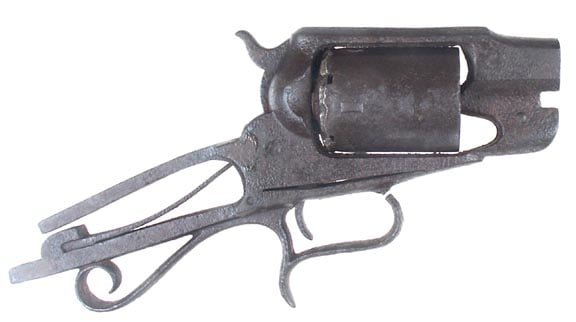
What was the most common configuration encountered?
The .38 rimfire conversion, with a 24″ octagon barrel, small
blade front sight, buckhorn rear sight, and a two piece butt
plate, on a standard grade stock.
What was the least common configuration encountered?
The engraved model in any configuration is the most rare.
The scarcest by caliber is the .46 rimfire, while the 28″ and
30″ barrel models were rare as well. By far, most unusual is
any of these rifles in a condition of 90% or better, with only
one being recorded at above 95%. It appears to me that with
such a low cost rifle, produced in such low numbers, and
with such a limited appeal, not much care was taken to insure
their condition lasted. I have seen a number of examples that
have fallen victim to black powder corrosion, as well as other
indicators of hard use during their lifetime. The most extreme
example I’ve seen, is also one of the scarcest. On this page is
of what remains of a .46 rimfire capping plate conversion
model.
Giving thought to the decision of E. Remington & Sons
to produce the Revolving Rifle, I think that this might be one
of those cases where the product was built, and then an
attempt was made to create a market. Realizing that the Civil
War, (‘The War of Northern Aggression”) was ending, not
only would military spending come to a halt, but there would
be a glut of
firearms, particu-
larly handguns
available for
personal use, so if
any firearms
would be sold,
they would have
to be targeted to
the public, be an
improvement over existing
models, be able to be produced inexpen-
sively, must be able to hit the market
rapidly, and utilize existing tooling and
experienced personnel as much as possible.
To accomplish all of this, E. Remington & Sons
could use existing tooling, capitalize on the excellent reputa-
tion that its handguns had gained, utilize existing inventory
and personnel, and immediately begin production on a
firearm that families could use in hunting small to medium size
game. Combine this with the fact that Remington needed to
enter the civilian long arm marketplace. Don’t forget that at
this same time, Remington was introducing the Beals single
shot rifle, and we can all see the similarity in the barrels and
stocks used on both rifles.
Why didn’t Remington’s revolving rifle succeed? Why
did production stop? My opinion is that with the marginal
design and it being a low power rifle, serious hunters weren’t
interested in it. Combine that with Winchester’s new lever
action repeater coming onto the scene, along with
Remington’s major emphasis going into producing the
rolling block military and civilian rifles, this product just
wasn’t one that could succeed.
| Page 35 | 2nd Quarter 2007 |
Where do I plan to take this study from here?
Still harboring a high level of interest that I had when I started this project, my immediate plans are to continue gathering
information by way of my survey form, and conduct a statistical analysis of the data. My hopes are that with professional help
in that arena, mathematics will give us a more accurate picture of the how’s and why’s of the production of this rifle. My mid-
range plans include completing a project that I have started which is to compile a complete set of scaled drawings of all of the
component parts of the rifle. This could take the better part of another year of available spare time. My dreams are probably no
different than many of yours in that I’d like my grandkids to have a copy of my book on Remington Revolving Rifles on their
bookshelf.
A big debt of gratitude goes out to the late Leon Wier Jr., our Journal Editor, Roy Marcot, RSA Past President Fritz Beahr,
and other RSA members for all of their help getting me started… helping me over hurdles along the way… and for sharing files
and photos that they had gathered over the years… and special thanks to Joe Poyer for his magnificent photography.
Mike Strietbeck
| Page 36 | 2nd Quarter 2007 |
| On-line Search/Sort Journal Index |
On-line Journal Articles New Journals have links to
|

